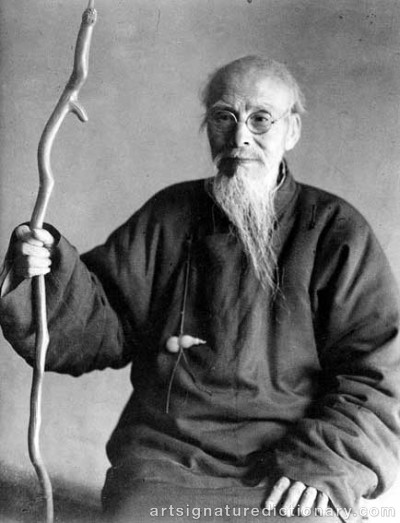
QI BAISHI
1864–1957, China
Biography
Discover the life and artistic journey of QI BAISHI (born 1864, China, died 1957, China), including key biographical details that provide essential context for signature authentication and artwork verification. Understanding an artist's background, artistic periods, and career timeline is crucial for distinguishing authentic signatures from forgeries.
Qi Baishi (1863-1957) was born in 1863 in Xiangtan County, Hunan Province. In his early youth he was trained as a woodcarver and soon became a master in this discipline. Later he turned to painting, poetry, calligraphy and seal carving.
Starting to paint at a rather late age, Qi was compelled to experiment with new forms of art. He obsessively copied different features and motifs from the famous Qing Dynasty painting manual The Mustard Seed Garden. Qi experimented with many different forms and styles of painting both from China and the West. Under the strong influence of Xu Wei, Bada Shanren and Wu Changshuo, he slowly started to develop a unique and more modern style of his own. Like the masters of the Qing who stressed the importance of subjective expression and a strong sense of individuality, Qi took this Xie Yi style, namely, painting ones feelings and mood rather than painting realistically, to new heights. Like the great masters which influenced his art, Qi Baishi's style and technique is classified as Da Xieyi, or 'Big' Xieyi. As opposed to the 'Small' Xieyi style here the artist uses large brushes and economy of line to capture the spirit of the subject with swift and vigorous strokes. Qi's paintings carry a strong sense of modernity and unique originality. Focusing mainly on flowers, birds, fish and insects, Qi gives his brush the kind of independence that very few artists dare to experiment with. His swift, sure, spontaneous brush strokes usually perfected only at an old age, turned Qi into China's most celebrated modern artist and indeed one of the worlds greatest painters. Qi Baishi is the Picasso of China. His simplicity, his forceful brush coupled with a strong sense of naivety and an almost child-like crudeness, combined to give the viewer some of the most powerful images in Chinese traditional art. In spite of his skills and complex compositions, Qi's art conveys a slightly awkward air which is the essence of his appeal. His most famous and attractive paintings were of shrimps and today one can refer to Qi's specific style of shrimp paintings as one can refer to Xu Beihong's horses, both artists gave these animals characteristic features that were immediately recognized by the Chinese as different and striking. Both artists had great influence over the evolotuion of modern Chinese art.
Qi's mature style emerged only in the 1920's after he moved to Beijing, he was only fully recognized at the old age of sixty but continued to create and produced his greatest masterpieces during his seventies and eighties. He died in Beijing on September 16, 1957 at the age of 94.
-------------------------
Qi Baishi (齊白石, 1864-1957) was one of the most well-known contemporary Chinese painters. His original name is Qi Huang (齊璜) and style name Weiqing (渭清). Baishi ("white stone") is one of his pseudonyms. Some of Qi's major influences include the Ming Dynasty artist Xu Wei (徐渭) and the early Qing Dynasty painter Zhu Da (朱耷, 即"八大山人"). The subjects of his paintings include almost everything, commonly animals, scenery, figures, vegetables, and so on. In his later years, many of his works depict mice, shrimps, or birds. Qi Baishi is particularly known for painting shrimps.
Explore other artists
Discover other notable artists who were contemporaries of QI BAISHI. These artists worked during the same period, offering valuable insights into artistic movements, signature styles, and authentication practices. Exploring related artists makes it easier to recognize common characteristics and artistic conventions of their era.